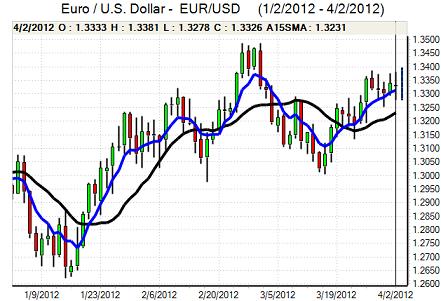EUR/USD
The Euro was unable to break resistance in the 1.3380 region against the dollar in early Europe on Monday and initially steadied around the 1.3330 region. The final PMI manufacturing reading was unchanged at 47.7 for March, but there was a significant deterioration in France and the peripheral reading also remained firmly trapped in recession territory.
Euro-zone unemployment increased to a fresh record high of 10.8% for March from 10.7% previously. Although the data was in line with expectations, there were further concerns surrounding structural weaknesses, especially with youth unemployment continuing to increase to record highs. The elevated unemployment levels will also increase concerns over potential social tensions.
The Euro dipped sharply against the yen ahead of the US open and this helped push the Euro to lows below 1.33 against the dollar.
The US manufacturing PMI release was close to expectations with a small increase to 53.4 for March from 52.4 previously. The orders component was slightly weaker over the month, but there was an increase in the employment index which will increase hopes for a solid manufacturing reading in Friday’s payroll report.
Although regional Fed President Pianalto stated that any further monetary easing could endanger price stability, there was nothing in the comments which suggested any move towards backing a tighter policy and the overall impact was limited.
The dollar was generally unable to make any significant headway with significant losses against the Canadian dollar and the Euro rallied back to above the 1.3300 level with no major changes during the Asian session.

Source: VantagePoint Intermarket Analysis Software
Call now and you will be provided with FREE recent forecasts
that are up to 86% accurate* 800-732-5407
If you would rather have the recent forecasts sent to you, please go here
Yen
The dollar was unable to retest resistance levels in the 83.20 area in Europe on Monday and dipped sharply with lows close to 82 before fresh bidding support emerged.
There had been a sharp shift in market positioning in favour of short yen positions and fresh yen gains triggered significant stop-loss yen buying, especially on the crosses. Markets also took a generally more sceptical surrounding risk appetite with doubts surrounding the Chinese PMI data.
The dollar gained some protection from the PMI data with reduced speculation over further Federal Reserve easing, but there was a further sell-off in late New York with a dollar slide to a 3-week low in the 81.60 area as there was reduced net support on yield grounds.
Sterling
Sterling held a firm tone in Europe on Monday as it looked to consolidate above the 1.60 level against the dollar.
The UK PMI manufacturing index rose to 52.1 from a revised 51.5 previously which was the highest reading for 10 months. The data will help underpin confidence in the economy to some extent, but there will also be concerns that the gains in output were due to a large extent by inventory accumulation, especially in the consumer sector which increases the risk that future output will stall.
Wider US gains were instrumental in pushing the UK currency weaker, but there was still solid buying support on dips and the overall trade-weighted index pushed to a 13-month high as the Euro again retreated towards the 0.83 region.
The services PMI data will be extremely important for sentiment on Wednesday and a solid release would reinforce more positive sentiment towards the UK economy. The latest Chambers of Commerce quarterly outlook was more positive and Sterling held above the 1.60 level.
Swiss franc
The dollar found some support at 0.90 against the franc on Monday and rallied to the 0.9070 region, but it was unable to sustain the advance. The Euro was unable to make any significant headway against the Swiss currency, trapped below the 1.2050 region.
The Swiss PMI index rose to 51.1 for March from 49 previously which will help ease growth fears slightly. At the margin, industrial expansion would lessen pressure for franc gains to be resisted, although the positive impact will be limited. Markets will be very nervous over central bank action if the Euro slides closer to the 1.20 level.

Source: VantagePoint Intermarket Analysis Software
Call now and you will be provided with FREE recent forecasts
that are up to 86% accurate* 800-732-5407
If you would rather have the recent forecasts sent to you, please go here
Australian dollar
The Australian dollar failed to hold gains during the European session on Monday and retreated to lows below 1.0380 before finding support and rallying back to the 1.0450 region later in the US session.
The Reserve Bank held interest rates at 4.25% following the latest monetary policy meeting. There was a downgrading of growth forecasts within the statement and some concerns over the regional outlook which suggested that the bank would be prepared to cut rates over the next few months and this had an important impact in curbing Australian dollar support with a retreat back to the 1.04 area.



